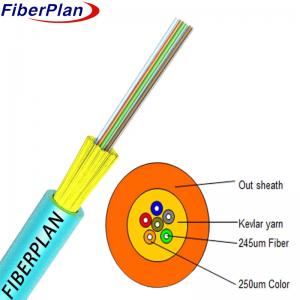
Add to Cart
Mini Bare Kevlar Strengthen Fiber Distribution Fiber Optic Cable
Description
The break-out indoor cable is constructed using simplex cables as subunits. In the center of the core, a non-
metallic strength member made of Fiber Reinforced Plastic (FRP) provides structural support. The subunits
are stranded around this central core. To enhance protection and safety, the cable is finished with a jacket
made of either PVC or LSZH (Low Smoke, Zero Halogen, Flame-retardant) material. This design ensures
durability, flexibility, and compliance with safety standards for indoor applications.
Application
1 Indoor Cabling, Breakout Applications: Specifically designed for indoor cabling, this cable is well-suited for
breakout scenarios, providing reliable connectivity within buildings.
2 Pigtail for Communication Equipment: Functions seamlessly as a pigtail for communication equipment,
ensuring efficient and dependable connections.
3 Compatibility with Communication Equipment: Tailored to meet the requirements of communication equipment,
ensuring suitability and effective service.
4 All-Purpose Mini Indoor Cable: Versatile and compact, serving as an all-purpose mini indoor cable suitable
for various communication needs.
5 MPO, MTP Connector Compatibility: Designed to work seamlessly with MPO and MTP connectors, offering
flexibility and compatibility with different connector types.
Characteristics
1 Ideal for indoor distribution, suitable for creating patch cords and pigtails.
2 Features a multi-cable design with independent strength members.
3 Utilizes a non-metal central strength member for durability.
4 Enhanced strength with high-strength Kevlar yarn member.
Cable Mechanical characteristic
| Items | Cable diameter | Weight | |||||
| 24 cores | 10 | 54.00kg/km | |||||
| 48 cores | 10 | 78.00kg/km | |||||
| 72 cores | 11.5 | 90.00kg/km | |||||
| 96 cores | 12.5 | 115.00kg/km | |||||
| 144 cores | 14.5 | 135.00kg/km | |||||
| Storage temperature(℃) | -20 ~ +60 | ||||||
| Min Bending Radius(mm) | Long term | 10D | |||||
| Min Bending Radius(mm) | Short term | 20D | |||||
| Min allowable Tensile Strength(N) | Long term | 1000 | |||||
| Min allowable Tensile Strength(N) | Short term | 2000 | |||||
| Crush Load (N/100mm) | Long term | 1000 | |||||
| Crush Load (N/100mm) | short term | 2000 | |||||
Fiber characteristic
| Fiber style | Unit | SM G652 |
SM G652D |
MM 50/125 |
MM 62.5/125 |
MM OM3-300 |
|
| condition | nm | 1310/1550 | 1310/1550 | 850/1300 | 850/1300 | 850/1300 | |
| attenuation | dB/km | ≤ | ≤ | ≤ | ≤3.0/1.0 | ≤3.0/1.0 | |
| 0.36/0.23 | 0.34/0.22 | 3.0/1.0 | ---- | ---- | |||
| Dispresion | 1550nm | Ps/(nm*km) | ---- | ≤18 | ---- | ---- | Dispresion |
| 1625nm | Ps/(nm*km) | ---- | ≤22 | ---- | ---- | ||
| Bandwith | 850nm | MHZ.KM | ---- | ---- | ≧400 | ≧160 | Bandwith |
| 1300nm | MHZ.KM | ---- | ---- | ≧800 | ≧500 | ||
| Zero dispersion wavelength | nm | 1300-1324 | ≧1302, ≤1322 |
---- | ---- | ≧ 1295, ≤1320 |
|
| Zero dispresion slope | nm | ≤0.092 | ≤0.091 | ---- | ---- | ---- | |
| PMD Maximum Individual Fibr | ≤0.2 | ≤0.2 | ---- | ---- | ≤0.11 | ||
| PMD Design Link Value | Ps(nm2*k m) |
≤0.12 | ≤0.08 | ---- | ---- | ---- | |
| Fibre cutoff wavelength λc | nm | ≧ 1180, ≤1330 |
≧1180, ≤1330 |
---- | ---- | ---- | |
| Cable sutoff wavelength λcc |
nm | ≤1260 | ≤1260 | ---- | ---- | ---- | |
| MFD | 1310nm | um | 9.2±0.4 | 9.2±0.4 | ---- | ---- | ---- |
| 1550nm | um | 10.4±0.8 | 10.4±0.8 | ---- | ---- | ---- | |
| Numerical Aperture(NA) |
---- | ---- | 0.200±0.015 | 0.275±0. 015 |
0.200±0 .015 |
||
| Step(mean of bidirectional measurement) |
dB | ≤0.05 | ≤0.05 | ≤0.10 | ≤0.10 | ≤0.10 | |
| Irregularities over fiber length and point |
dB | ≤0.05 | ≤0.05 | ≤0.10 | ≤0.10 | ≤0.10 | |